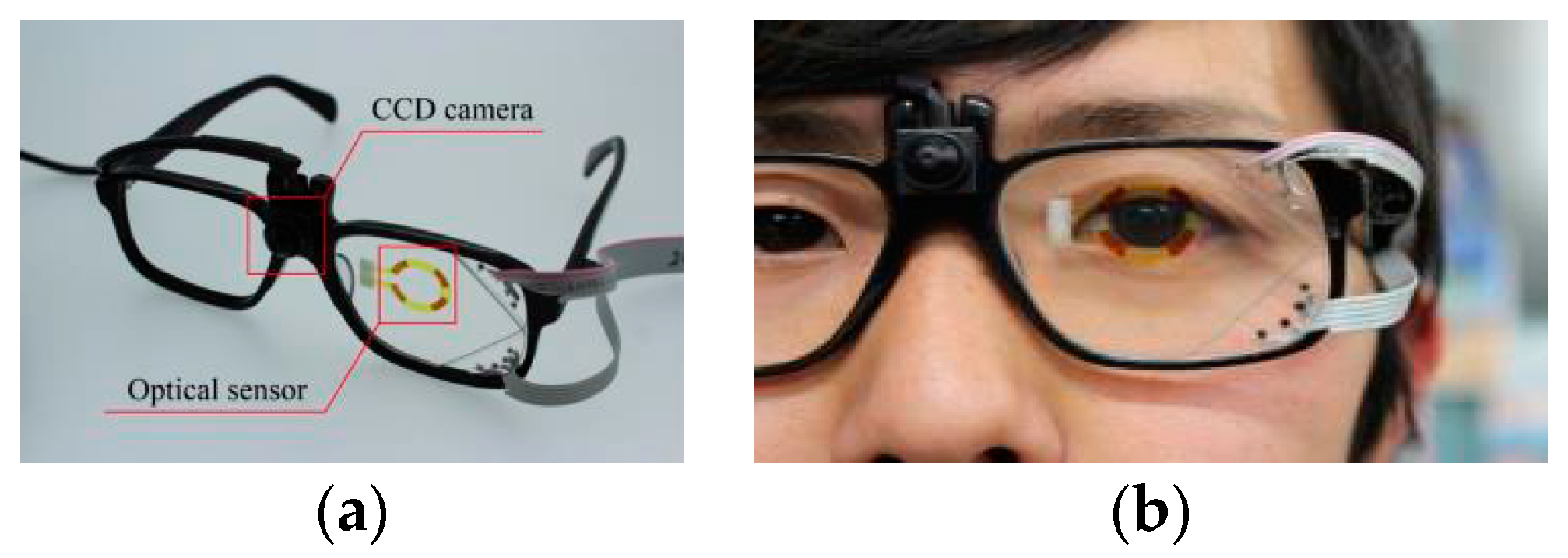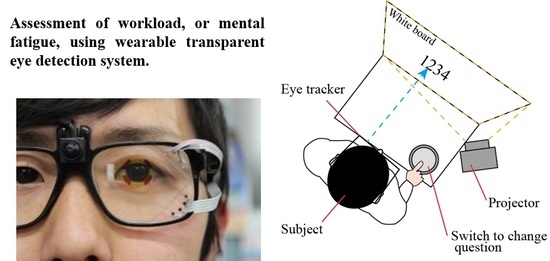Mental Fatigue Monitoring Using a Wearable Transparent Eye Detection System
Abstract
:1. Introduction

2. Experimental Section
2.1. Concept of the Wearable Eye Detection System


2.2. Experimental Protocol
2.2.1. NASA-TLX
2.2.2. Tasks and Measurement

2.2.3. Analysis
3. Results and Discussion
3.1. Workload of the Requested Tasks
| The Number of the Tasks | Workload | ||||
|---|---|---|---|---|---|
| A | B | C | D | E | |
| 1 | 60.0 | 63.5 | 26.3 | 63.5 | 46.3 |
| 2 | 59.0 | 58.3 | 33.3 | 58.3 | 62.3 |
| 3 | 66.0 | 61.7 | 20.7 | 61.7 | 57.1 |
| 4 | 72.0 | 60.7 | 55.3 | 60.7 | 66.0 |
| 5 | 86.3 | 54.7 | 52.3 | 54.7 | 75.0 |
| 6 | 93.0 | 76.9 | 56.3 | 76.9 | 85.7 |
3.2. Information Acquired by the Eye-Tracking System and the Correlation with the Workload
4. Conclusions
Supplementary Materials
Acknowledgments
Author Contributions
Conflicts of Interest
References
- Hancock, P.A.; Meshkati, N. Development of NASA-TLX (Task Load Index). Results of empirical and theoretical research. In Human Mental Workload; Elsevier: Amsterdam, The Netherlands, 1988; pp. 139–183. [Google Scholar]
- Ali, N.; Pruessner, J.C. The salivary alpha amylase over cortisol ratio as a marker to assess dysregulations of the stress systems. Physiol. Behav. 2012, 106, 65–72. [Google Scholar] [PubMed]
- Rai, B.; Kaur, J. Salivary stress markers and psychological stress in simulated microgravity: 21 days in 6° head-down tilt. J. Oral Sci. 2011, 53, 103–107. [Google Scholar]
- Fukui, M.; Hinodde, D.; Yokoyama, M.; Yoshioka, M.; Kataoka, K.; Ito, H.O. Levels of salivary stress markers in patients with anxiety about halitosis. Arch. Oral Biol. 2010, 55, 842–847. [Google Scholar]
- Mardi, Z.; Ashtiani, S.N.M.; Mikaili, M. EEG-based drowsiness detection for safe driving using chaotic features and statistical tests. J. Med. Signals Sens. 2011, 1, 130–137. [Google Scholar] [PubMed]
- Sauvet, F.; Bougard, C.; Coroenne, M.; Lely, L.; van Beers, P.; Elbaz, M.; Guillard, M.; Leger, D.; Chennaoui, M. In-flight automatic detection of vigilance states using a single EEG channel. IEEE Trans. Biomed. Eng. 2014, 61, 2840–2847. [Google Scholar]
- Nishinaka, Y.; Jun, R.; Prihandana, G.S.; Miki, N. Fabrication of polymer microneedle electrodes coated with nanoporous parylene. Jpn. J. Appl. Phys. 2013, 52, 06GL10. [Google Scholar]
- Arai, M.; Nishinaka, Y.; Miki, N. Electroencephalogram measurement using polymer-based dry microneedle electrode. Jpn. J. Appl. Phys. 2015, 54, 06FP14. [Google Scholar] [CrossRef]
- Egelund, N. Spectral analysis of heart rate variability as an indicator of driver fatigue. Ergon 1982, 23, 663–672. [Google Scholar]
- Hjortskov, N.; Rissen, D.; Blangsted, A.K.; Fallentin, N.; Lundberg, U.; Sagaard, K. The effect of mental stress on heart rate variability and blood pressure during computer work. Eur. J. Appl. Physiol. 2004, 92, 84–89. [Google Scholar] [CrossRef] [PubMed]
- Vuksanovic, V.; Gal, V. Heart rate variability in mental stress aloud. Med. Eng. Phys. 2007, 29, 344–349. [Google Scholar] [CrossRef] [PubMed]
- Alghowinem, S.; Goecke, R.; Wagner, M.; Parker, G.; Breakspear, M. Eye movement analysis for depression detection. In Proceedings of the 20th IEEE International Conference on Image Processing (ICIP), Melborne, Australia, 15–18 September 2013; pp. 4220–4224.
- Lee, B.G.; Jung, S.J.; Chung, W.Y. Real-time physicological and vision monitoring of vehicle driver for non-intrusive drowsiness detection. IET Comm. 1998, 5, 2461–2469. [Google Scholar]
- Hess, E.H. Attitude and pupil size. Sci. Am. 1965, 212, 46–54. [Google Scholar]
- Zhu, Z.; Ji, Q. Novel eye gaze tracking techniques under natural head movement. IEEE Trans. Biomed. Eng. 2007, 54, 2246–2260. [Google Scholar] [PubMed]
- Hennessey, C.; Noureddin, B.; Lawrence, P. A single camera eye-gaze tracking system with free head motion. In Proceedings of the 2006 Symposium on Eye Tracking Research & Applications, San Diego, CA, USA, 27–29 March 2006; pp. 87–94.
- Nitschke, C.; Nakazawa, A.; Takemura, H. Display-camera calibration using eye reflections and geometry constraints. Comput. Vis. Image Und. 2011, 115, 835–853. [Google Scholar]
- Shigeoka, T.; Ninomiya, T.; Muro, T.; Miki, N. Wearable pupil position detection system utilizing dye-sensitized photovoltaic devices. Sens. Actuators A Phys. 2008, 145–146, 103–108. [Google Scholar] [CrossRef]
- Ozawa, M.; Sampei, K.; Torres, C.C.C.; Ogawa, M.; Oikawa, A.; Miki, N. Wearable line-of-sight detection system using micro-fabricated transparent optical sensors on eyeglasses. Sens. Actuators A Phys. 2014, 205, 208–214. [Google Scholar]
- Torres, C.C.C.; Sampei, K.; Ogawa, M.; Ozawa, M.; Miki, N. Crosstalk analysis, its effects and reduction techniques among photovoltaic devices used as transparent optical sensors for a wearable line-of-sight detection system. Jpn. J. Appl. Phys. 2015, 54, 06FP16. [Google Scholar] [CrossRef]
- O’Regan, B.; Graetzel, M. A low cost, high-efficiency solar cell based on dye sensitized colloidal TiO2 films. Nature 1991, 353, 737–740. [Google Scholar] [CrossRef]
- Ingre, M.; AKerstedt, T.; Peters, B.; Anund, A.; Kecklund, G. Subjective sleepiness, simulated driving performance and blink duration: Examining individual differences. J. Sleep Res. 2006, 15, 47–53. [Google Scholar] [PubMed]
© 2016 by the authors. Licensee MDPI, Basel, Switzerland. This article is an open access article distributed under the terms and conditions of the Creative Commons by Attribution (CC-BY) license ( http://creativecommons.org/licenses/by/4.0/).
Share and Cite
Sampei, K.; Ogawa, M.; Torres, C.C.C.; Sato, M.; Miki, N. Mental Fatigue Monitoring Using a Wearable Transparent Eye Detection System. Micromachines 2016, 7, 20. https://doi.org/10.3390/mi7020020
Sampei K, Ogawa M, Torres CCC, Sato M, Miki N. Mental Fatigue Monitoring Using a Wearable Transparent Eye Detection System. Micromachines. 2016; 7(2):20. https://doi.org/10.3390/mi7020020
Chicago/Turabian StyleSampei, Kota, Miho Ogawa, Carlos Cesar Cortes Torres, Munehiko Sato, and Norihisa Miki. 2016. "Mental Fatigue Monitoring Using a Wearable Transparent Eye Detection System" Micromachines 7, no. 2: 20. https://doi.org/10.3390/mi7020020







